Sharrow MX3 Prop Tested on Robalo R302
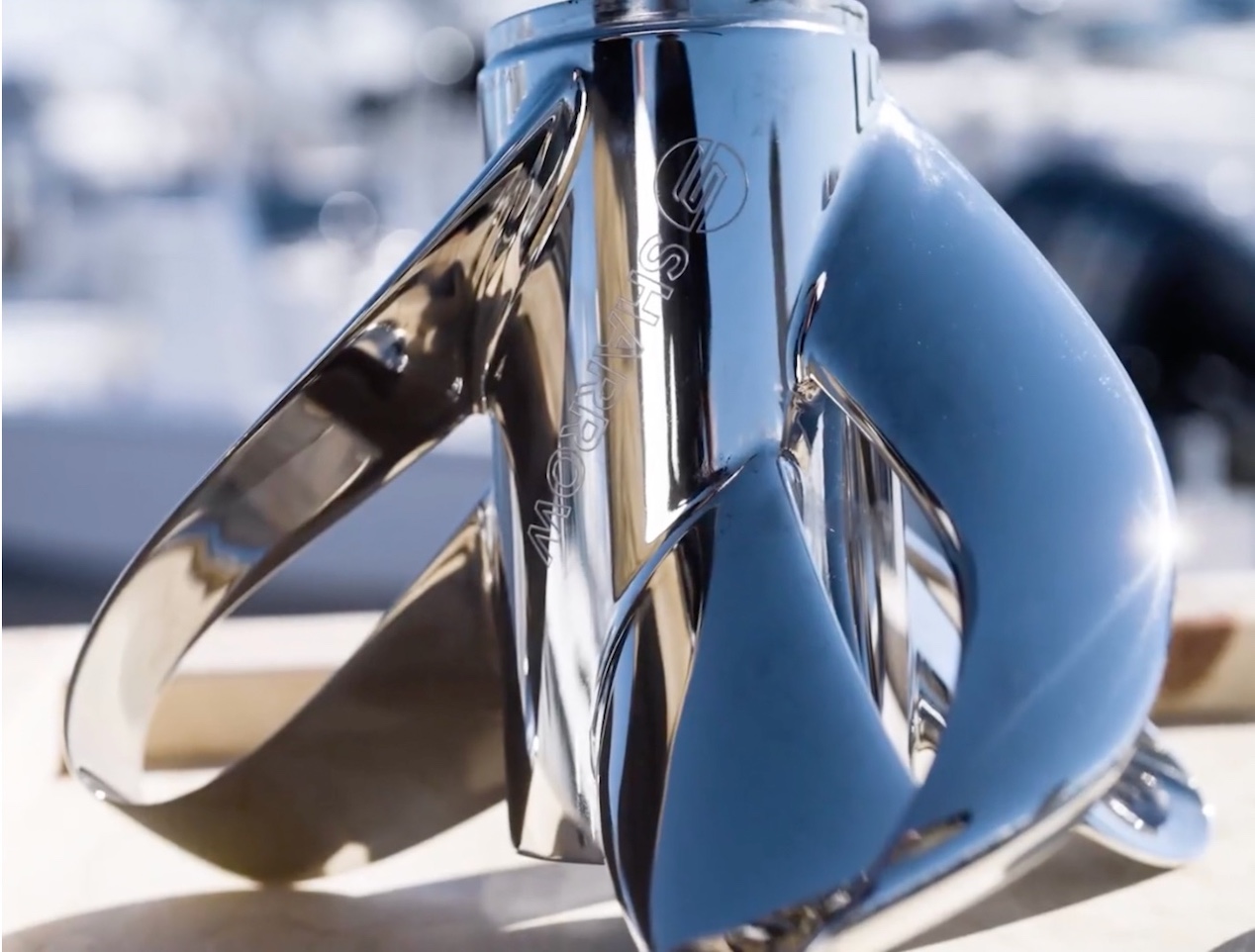
We’ve been testing the Sharrow loop propeller for some time now and its design is no secret. With closed-loop blades, there is no wasted energy from vortices spinning off the ends of the blades. This results in a much more efficient workforce with every rotation. We’ve shown this time and again but, in our previous tests, some have said that they weren’t happy that the tests were with specifically built boats, and props engineered to them. Message received and we took that as a call to action.
The Boat
BoatTEST recently conducted a test on the innovative Sharrow propellers, but due to popular demand, this one was a little different. We didn’t test it on a commercial boat, or a large catamaran, a massive center console, or a tiny bowrider. No, this time it was on what is probably the most average size, weight and category of boat out there… the Robalo R302.

The Props
Moreover, this test was not conducted on props specifically made for a specific boat or dialed in by Sharrow engineers. These were the new MX3 props that were made for the range of Yamaha V6 series of engines. They come in 22 different pitch sizes for both left and right-hand rotation (44 total). Furthermore, we took the most popular pitched version at 19” (48.26 cm) right off the shelf and put on the boat.
So to recap… the most popular size boat, most average weight, most popular sized props… this is everyman’s test.
Let’s Establish a Baseline
We begin by conducting a test on the stock props, which in this case were Saltwater Series II 15.25 x 19 three-bladed stainless-steel models, just like on most of these engines. Here’s what we found on the first test.

With our test boat having a test weight of 11,220 lbs. (5089.31 kg) and the twin 300-hp Yamaha four-strokes run up to 5700 RPM, our speed topped out at 51.5 MPH. Best cruise was reached at 4000 RPM and 32.9 MPH. At that speed, the 22.2 GPH fuel burn translated into 1.5 MPG and a range of 400 statute miles. All while still holding back a 10% reserve of the boat’s 300-gal (1135.62L) total fuel capacity.
Now Let’s Switch Props
So much for the first test, and establishing a baseline from which to measure against. Now we switch to the Sharrow MX3 19” (48.26 cm) prop and run the same test parameters again. Here’s what we found.

Our top speed of 51 was achieved at 5750 RPM. This time the best cruise was lowered to 25.7 RPM and 3000 RPM. At that speed, the 14.6 GPH fuel burn resulted in a range of 477 statute miles. This, while still holding back a 10% reserve of the total 300-gal (1135.62L) total fuel supply.
So Let’s Do Some Comparisons
So now we have our two tests. Now let’s dig a little deeper into the differences between the two.
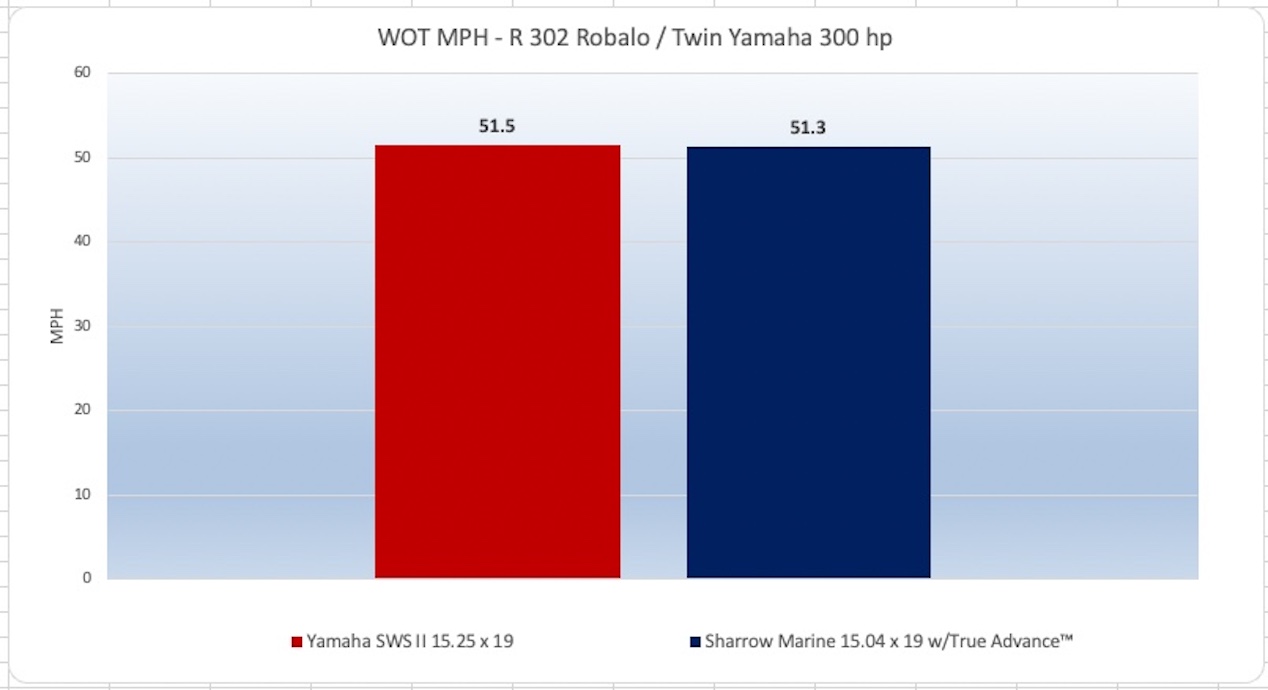
First of all, the top speeds between the two props had reasonably similar results, with the Yamaha edging out the Sharrow by only a slight margin. 51.5 MPH vs 51.3 MPH.
Next, let’s look at the efficiency by comparing the two props at similar speeds. It’s here where things start to get interesting. We can see how when we graph the two test results together there’s a marked improvement in the Sharrow prop. In fact, at one point the results show a 26% improvement over the standard propeller.

That improvement in efficiency will naturally affect the range of our Robalo. When we compare the range at varying speed settings we, yet again, see marked improvements. At much as 26% or 96 miles at one point. This is a remarkable distinction as that can make a big difference when running offshore, or even when having to divert due to weather.
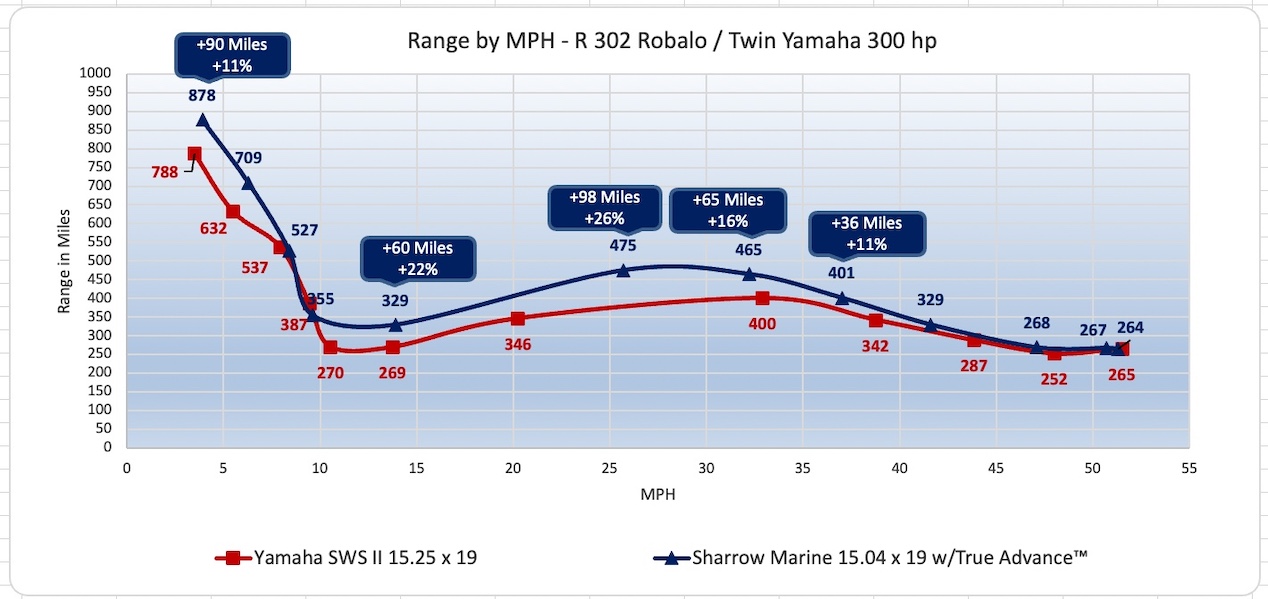
Efficiency is the Key and Advance Rate is How it’s Achieved.
All of this enhanced performance is what makes the Sharrow prop so remarkable. Because it’s so efficient, everything that the prop does is better when compared to a standard prop. Now, the way we measure efficiency is by determining how much better the prop performs with each rotation. And when comparing the two props in that manner, we can see that there’s a huge improvement in the mid-range, at much as 84% at 3000 RPM and 59% at 3500.
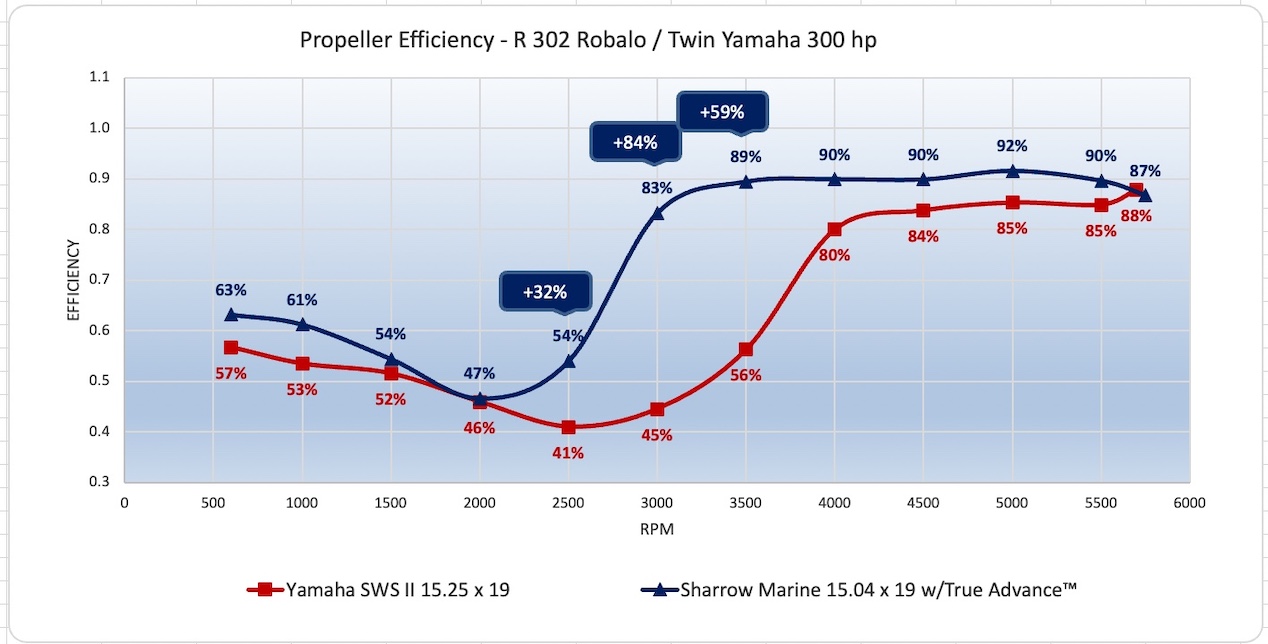
The way this efficiency comes about is through the prop’s advance rate. It’s just what it sounds like… at what rate does the prop advance with each rotation?
If the propeller were in a solid, then it’s easy to imagine the 19” (48.26 cm) pitch prop moving forward the full 19” (48.26 cm). But it’s not in a solid, it’s in a liquid. So as the prop pushed against the water, the water moves away from the prop. The result is that any prop of a given pitch will not move ahead that theoretical amount. The difference between what it should do and what it does do is called propeller slip. With Sharrow’s unique design, that propeller slip is minimized, and the advance rate is therefore maximized.
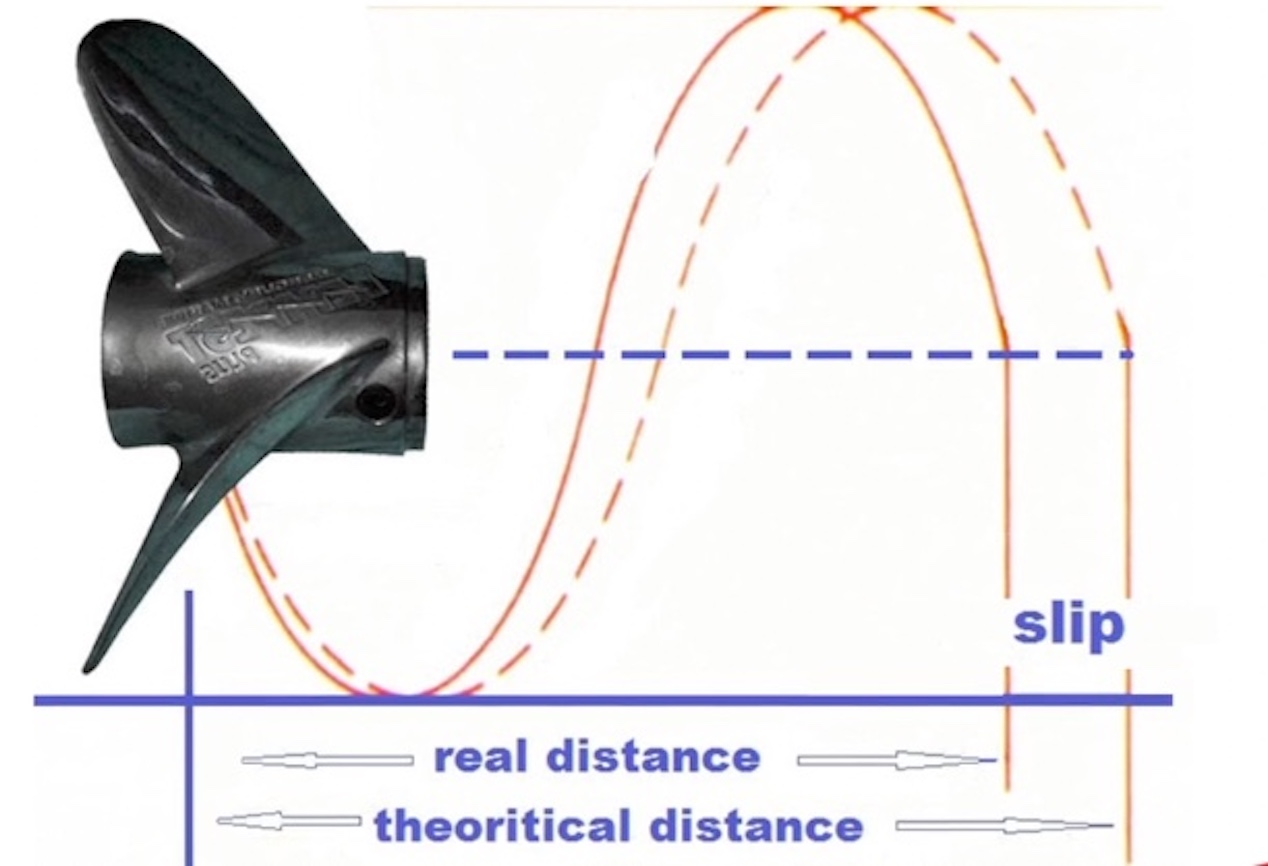
So just how much more efficient is the Sharrow prop’s advance rate? A lot actually. Especially in the sweet spot, right in the mid-range. At the beginning, the difference is negligible since both props aren’t working very hard at pushing against the water. Even still, the Sharrow has the advantage at every step. But start running at 2500 RPM and things really open up. The Sharrow’s advance rate is a full 32% improved at that speed and it only gets better until it maxs out at a whopping 87% at 3000 RPM. By 4000 RPM the improvement levels out around 17% until the standard prop finally takes over the lead by a very slim margin.
So, the takeaway here is that the Sharrow prop is built to improve the efficiency in the area where we most run our boats… right in the mid-range. It’s not for winning races, it’s for winning at the fuel pump.

Improved Handling
The biggest surprise with the Sharrow props installed on your boat will be in the improved handling. The moment the throttle is moved into gear, the typical rumble and vibration, that was thought to be from the engine and drive, is gone as it turns out that was all from the prop in the first place.
Cruising is also improved. With the standard prop, it was taking us ½ to ¾ of a turn on the wheel just to maintain the course. With the Sharrow props we could simply drive hands off and the boats tracked straight and true.
Even backing down was better. With a lot of power to bring out the worst, we backed down with the wheel hard over with the regular props installed. The boat turned but not by a lot. Reverse the wheel and the turning would slow, then stop and finally reverse direction. But with the Sharrow props, the turns were much more pronounced, and when reversing the direction the change was nearly instantaneous.
Observations
If the Sharrow prop made even a little performance improvement, that would be something. If the range got just a little better, it’d be noticeable, but worth the price… probably. If we saved even a little at the pump, it’d be a big seller just the same. Improved handling? That’s also a deal-maker but not to the entire boating market.
But what if all those improvements were so dramatic that it was hard to believe? That’s the way it is with the Sharrow props. It’s not any one thing that makes them fly off the shelves, it’s the combination of all of them, and by a wide margin. It’s nothing short of dramatic to see the difference firsthand.